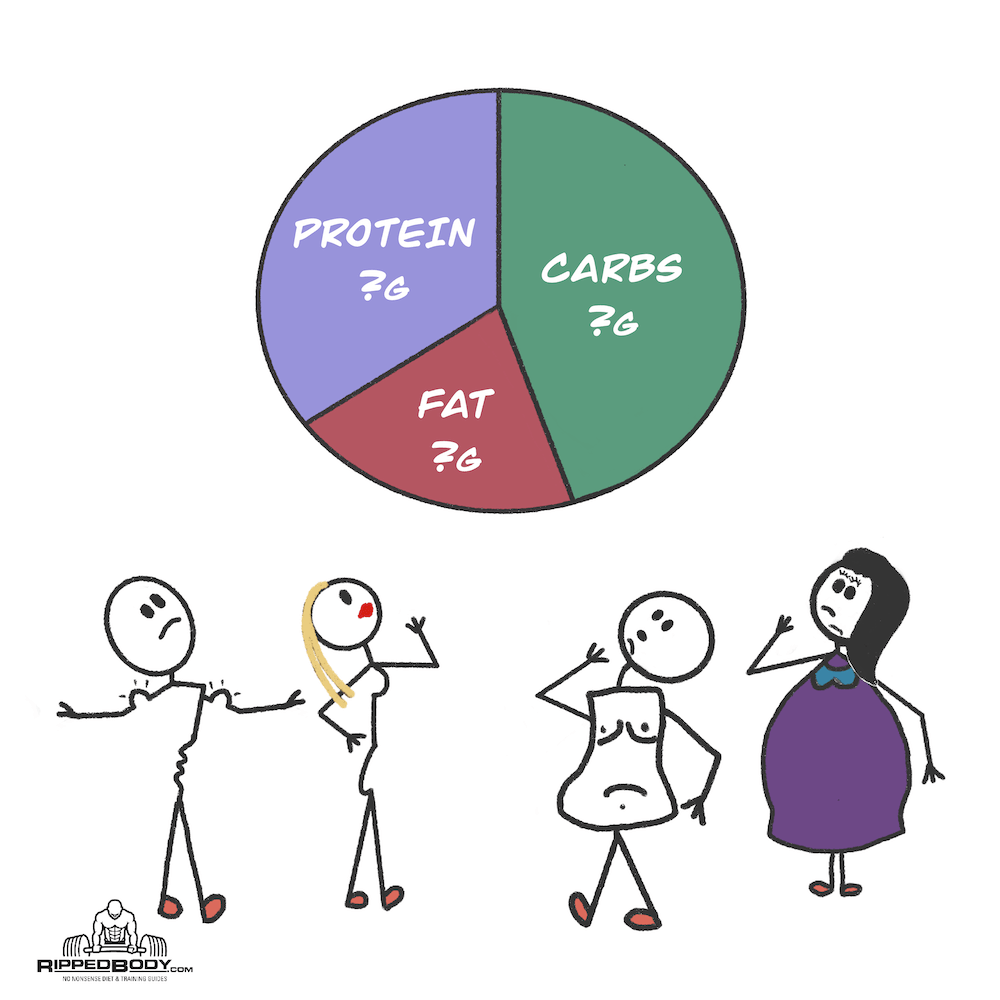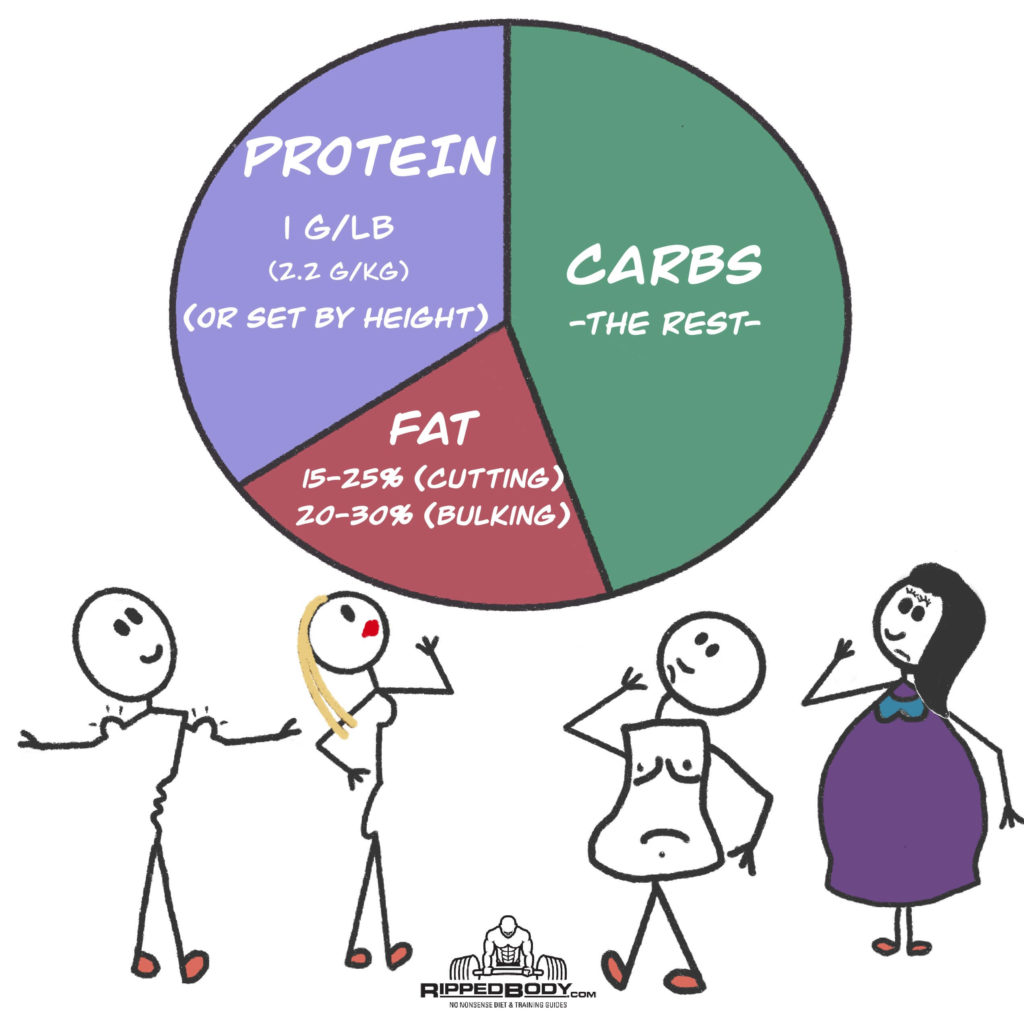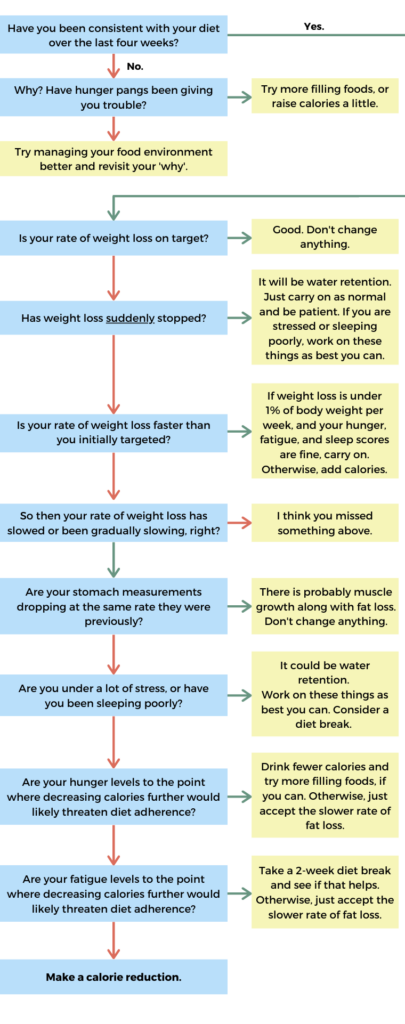Calculate your daily calorie and macronutrient needs based on your goals.
Basic Details
Activity, Goals & Preferences
📊 Your Results
Based on your inputs, here are your calculated nutritional targets
📈 Metabolic Data
🍽️ Daily Macros
📊 Macro Breakdown
⏱️ Estimated Timeline
Note: This is an estimate based on theoretical calculations. Your actual results may vary due to factors such as metabolic adaptation, training quality (get our free programs), individual genetic differences, and, naturally, how well you adhere. Regular progress tracking and diet adjustments will be needed.
🎛️ Adjust Your Macros
Note: These calculations incorporate the activity levels and macro setting recommendations from my Muscle and Strength Pyramid: Nutrition book (they are all explained below), and utilize Greg Nuckols’ MacroFactor BMR formulas.
Sliders: When adjusting calories, protein stays constant while carbs and fats adjust in a 2:1 ratio (2 parts carbs to 1 part fat by calories). When adjusting protein, calories stay constant. When adjusting carbs or fats, protein and calories remain constant.
I highly recommend reading the notes below to understand how it works and its limitations.

1. “Does This Calculator Work? why should I trust It?”
Well, you’re right to question what you find on the internet, especially in the charlatan-filled fitness industry. I can’t make you trust me, but I can explain how it’s built so that you can make your own informed decision.
The calculator utilizes a combination of Greg Nuckols’ MacroFactor BMR formulas and the activity multiplier and macro setting recommendations from my internationally bestselling book, The Muscle and Strength Pyramid: Nutrition. The former is one of the most popular nutrition loggers in the world, created by my dear friends over at StrongerbyScience. The latter is a fully referenced 300-page book that I co-authored with Dr. Eric Helms and Andrea Valdez. (It’s popular with physique competitors, powerlifters, and coaches. The trainers in your gym have probably heard of it.)
We’ve been coaching online as a full-time job since 2011. If we didn’t get results for our clients (view hundreds of our client results photos here), we wouldn’t still be in business.
How BMR Is Calculated
The basic details section is used to calculate your basal metabolic rate (BMR). Think of your BMR as your ‘coma calories’ — the energy intake you need, should you fall into a coma, to maintain your body weight. There are a variety of formulas to calculate BMR.
- Selecting that you’re in an energy deficit reduces calculated BMR by 5%. This is to take into account metabolic adaptation, not metabolic damage, and is a natural response to a calorie deficit.
- Selecting that you’re currently more than 10% below your all-time highest body weight reduces calculated BMR by 3%.
- If you enter an estimate of your body fat percentage, the calculator switches to a different set of equations, which will produce a slightly better estimate for those who are considerably higher or lower than average.
How Activity Multipliers Work
An activity multiplier in a macro calculator is a number used to estimate your Total Daily Energy Expenditure (TDEE) and is based on how active you are. It adjusts your Basal Metabolic Rate (BMR) — the calories you’d burn at rest — to account for daily movement and exercise.
Each activity level bump multiplies the BMR calculation by an additional 0.2. Choose the one that seems to fit you best, and don’t sweat your choice too much. — Calorie calculations are estimations. Our goal here is to get you a starting point that is in the right ballpark. Once you have enough tracking data, I will show you how to fine-tune it.
- Sedentary (<5,000 steps per day): Little to no daily activity. You have a desk job, drive everywhere, and sit most of the day. (x1.25)
- Mostly Sedentary (<5,000 steps per day) + strength training: As above, but you lift 3-6 days per week. (x1.45)
- Lightly Active (5,000-10,000 steps) + strength training: You lift 3-6 days per week, you’re on your feet a bit more — light walking or movement during the day, and you might do some other exercise once or twice per week. (x1.65)
- Active (10,000-15,000 steps) + strength training: Aside from lifting 3-6 days per week, you’re physically active most of the day, or do some other exercise on multiple days of the week. (x1.85)
- Highly Active (15,000+ steps) + strength training:: Aside from lifting 3-6 days per week, you have a very physically active job or participate in intense exercise most days per week. (x2.05)
I’ll explain how the macros (protein, carbs, and fat) are calculated in a moment. But first, you’re probably wondering whether your calculations are ‘correct’ for you. It’s natural to wonder that, but this shows a fundamental misunderstanding of how calculators work. That’s because…
2. You will need to adjust these macros sooner or later to achieve the desired rate of weight change
Why sooner? Because the calculations are based on equations derived from group averages. You might be on either side of this average, so consider them a starting point from which to adjust.
Why later? Because energy needs change over time as we diet and bulk. Your metabolism will gradually adapt to fight a caloric deficit, and energy needs increase when we gain weight. These things happen for some people more than others, and this is not something a calculator can predict.
For these two reasons, I don’t recommend using a calculator when transitioning between bulking and cutting. Use your progress data instead:
👉 How To Cut After Bulking
👉 How To Bulk After Cutting
Knowing how impatient people are to see results, we can factor in the metabolic adaptation into calorie and macro calculations.
But before we get into that…
People consistently make the same simple mistakes when acting on these calculations. So, I have built a Free 15-Day Transformation Kickstart Bundle that has helped 100,000 people so far avoid them. May I send that to you?
👉 Training & nutrition plan to kickstart progress.
👉 Science-backed strategies to avoid common mistakes.
📩 It’ll be in your inbox before you’re done reading — ready to help you take action. 👇
Your email won’t be shared, sold, or abused – ever.
So, as I was saying, I’ve factored the energy need adaptions into the calculations in the following couple of ways…
3. For those Who Have Already Been Dieting…
You’ll see two questions after you enter your height.
Are you currently in an energy deficit (i.e., are you currently losing weight)?
Being in an energy deficit tends to slightly decrease BMR. This is called metabolic adaptation, not metabolic damage, and is a natural response to a calorie deficit. Selecting this reduces calculated BMR by 5%.
Are you currently more than 10% below your all-time highest body weight?
Being in a weight-reduced state tends to slightly decrease BMR. Selecting this reduces calculated BMR by 3%.
Additionally, the total nerds among you (I love you guys!) who have been pulling out your calculators to check my math may have noticed that…
4. For those bulking, I’ve upped the caloric surplus by 50% to anticipate some of the increased energy needs when bulking
This is not an extreme change; we’re talking a 50 calorie bump per pound you are looking to gain each month.
The reason I did this is that there’s a tricky little bitch called NEAT, which can impact energy needs way more from person to person, especially when bulking.
NEAT is the nickname for ‘non-exercise activity thermogenesis,’ which is the energy expended for everything we do aside from sleeping, digesting food, or sports-like exercise. It ranges from the energy expended walking to work, typing and texting friends, shaking up a protein shake, performing yard work, and fidgeting.
Some people ramp up NEAT much more than others, which explains those who claim not to be able to gain weight. These people are commonly referred to as ‘hard gainers,’ but there is nothing wrong with them; they simply need to eat more.
This cannot be factored into the macro calculator, which is why tracking average weight changes and adjusting caloric intake based on the outcome is so critical.
5. So now you’re probably wondering, “What is a desirable rate of weight loss or gain?”
Weight loss: I recommend 0.5–0.75% of body weight loss per week when cutting. — The leaner you get, the slower you should take it. Most busy people will find anything faster than this unsustainable, due to increasing fatigue, hunger, and brain fog.
Weight gain: I recommend 0.5–2% of body weight gain per month when bulking. The more experienced a trainee you are, the closer you are to your genetic potential, so the slower you should take things.
- Beginner: Choose 1.5–2% (If you have no training experience and little history of regular physical activity, such as sports.)
- Novice: Choose 1–1.5% (If you can add load and/or reps each time you lift for most or all exercises. This phase can last years, but can be as short as 6 months with an appropriate dose, consistency, effort, recovery, and focus on progression.)
Intermediate: Choose 0.5–1% (If you can only add reps in the 10–20 rep range week-to-week, or for the lower rep ranges, add load month-to-month. Most never pass this phase. Can finish by year 4–5 with an appropriate dose, consistency, effort, recovery, and focus on progression.)
Advanced: Choose ≤0.5% (If you can add reps in the 10–20 rep range month-to-month, or for the lower rep ranges, add reps or load at slower rates. Most never reach this phase. Progress continually slows as you get closer and closer to your potential.)
Using the upper end of the ranges will make the changes easier to track, especially when you aren’t working with a coach and are doing things yourself.
6. Most people will have a jump in scale weight in the first week, especially when cutting
This will be due to the change in your body’s gut content, water, and muscle glycogen. It happens whenever you change the number of carbohydrates you eat or the total food intake in general.
So, before deciding to adjust, track for several weeks first, taking the average scale weight each day, and ignore the first week of data.
7. To make a macro adjustment to get your body weight change on track…
If you are cutting, multiply the amount you are off your weekly weight change target by 500 kcal (or 1100 kcal for those using kg). Add or subtract that from your caloric intake each day accordingly. Here are some examples:
- If you lose weight 0.5 lbs slower than your target each week, reduce caloric intake by 250 kcal daily (500*0.5). — This is approximately one cup of uncooked rice or 3 cups of cooked rice.
- If you lose weight 0.3 lbs faster than your target each week, increase caloric intake by 150 kcal daily (0.3*500). — This is approximately a 2 oz portion of uncooked pasta.
👉 More here: How to Adjust Calories and Macros as You Diet 📉
Make this caloric change via fat and carb changes per your preferences. This is as simple as follows:

If you are bulking, multiply the amount you are off your monthly weight change target by 150 kcal (or 330 kcal for those using kg). (These numbers are explained in my mega-guide on bulking). Here are some examples:
- If you’re gaining weight 1.5 lb slower than your target each month, increase daily caloric intake by 225 kcal (150*1.5).
- If you’re gaining weight 0.5 kg faster than your target each month, reduce daily caloric intake by ~165 kcal (330*0.5).
👉 More here: How to Adjust Calories and Macros as You Bulk 📈
Whether cutting or bulking, leave protein intake as is unless you have a lot of body fat to lose. (More on this in a moment.)
8. Before making any adjustments, make sure your adherence is on point
If your adherence is not on point, fix that before adjusting your macros. Solid adherence in the week, only to throw it away on the weekends, is the most common pattern people follow. This includes adherence to your workouts — your training routine needs to be routine; plans don’t mean anything if they aren’t followed through.
9. Double-check that you are tracking things accurately
Here’s my guide to counting macros and making meals out of them. (The simplified counting rules in this guide are what gave the food value estimations you saw at the end of the calculator.)
But despite guides like that trying to simplify, studies consistently show that people are terrible at tracking things. So, if you’re not losing weight at the rate desired and you’re concerned that your macros look low, swallow your ego and consider the possibility that you’ve screwed something up.
Log everything that passes your lips into a nutritional calculator for 2 weeks. This will tell you if you have an issue.
10. The Way Protein intake is calculated Depends On A Few Factors
Many calculators set protein intake based on total body weight. However, this can lead to an unnecessarily high protein intake, especially for individuals with a significant amount of fat to lose. This makes things difficult. Past a certain point, more protein isn’t beneficial; it’s a burden. It’s more expensive and makes it more difficult to hit your calorie budget without consuming too much fat. Swapping excess protein for carbs and fat will lead to better satiety, diet variety, and training quality.
To address this issue, if you have a good estimate of your body fat percentage (which should not be taken for granted, because all of the methods available for estimating body fat percentage are prone to large error levels, we calculate protein based on lean body mass (body weight minus fat). If you don’t have an estimate of your body fat percentage, we use your target body weight when cutting, and your current body weight when recomping or bulking.
When body fat percentage is known:
- Bulking or Recomposition: 1 g per pound of lean mass (2.2 g per kg)
- Cutting: 1.14 g per pound of lean mass (2.5 g per kg)
When body fat percentage is unknown:
- Bulking or Recomposition: 0.73 g per pound (1.6 g/kg) of body weight.
- Cutting: 1 g per pound (2.2 g/kg) of target body weight.
You could also consider setting protein intake based on your height in cm.

If you’re 260 lbs and 6’0, you can clearly see how the traditional “1 g per pound of body weight” recommendation is too high.
However, if you are targeting 20 lbs of fat loss, but you know you could likely lose 50 lbs of fat, then I recommend setting your target body weight as 210 lbs, because 240 g of protein would still be too high. You can cross-check this against the graph above; you want to be in that ballpark, but not too much higher.
Using whey protein to help you meet your numbers is fine, but real food tends to be more filling. Speaking about food, don’t worry about “complete” and “incomplete” proteins — whey and animal products may be the most “complete” proteins, but as long as you hit your targets by the end of the day, it won’t make a difference.
For a fuller explanation of these protein guidelines, including why protein needs are higher when dieting, see our article: How to Set Your Macros for Fat Loss and Muscle Growth.
References can be found in my book, The Muscle and Strength Pyramid: Nutrition.

12. Too many people make calorie and macro calculations, wait two weeks, then decide that they “don’t work” if they don’t see the calculated for scale weight change
They then move to another macro calculator (or diet method entirely). This is sadly common. Don’t be this person!
A simple adjustment of your caloric intake up or downwards is all that will be needed. (Reasons 2-4, at rates described in 5, in the manner described in 7.) Don’t make this mistake.
13. If you have already calculated your macros elsewhere and they aren’t radically different, I don’t suggest you change them
As I’ve covered, the key is that you track your progress and adjust based on the outcome. You’ll see I have several guides on that in the diet adjustments section of the nutrition articles page, where you’ll find helpful decision trees like this:

Privacy policy.